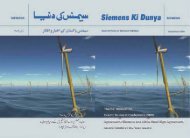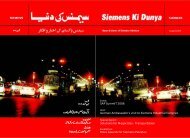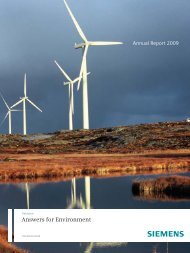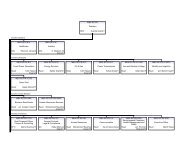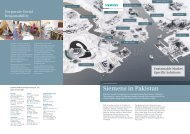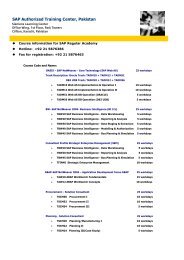Download - Siemens Pakistan
Download - Siemens Pakistan
Download - Siemens Pakistan
You also want an ePaper? Increase the reach of your titles
YUMPU automatically turns print PDFs into web optimized ePapers that Google loves.
132 Notes to the Financial Statements<br />
3.13 Foreign currencies<br />
Foreign currency transactions are translated into Pak Rupees at exchange rates prevailing on the date of transaction. Assets and liabilities<br />
(monetary items) in foreign currencies are translated at the rates of exchange prevailing at the balance sheet date. Exchange gains and losses are<br />
included in the profit and loss account currently.<br />
3.14 Revenue recognition<br />
Revenue from sale of goods are recognised when significant risks and rewards of ownership are transferred to the buyer. Service revenue is<br />
recognised over the contractual period or as and when services are rendered to customers. Commission income is recognised on receipt of credit<br />
note. Financial income is recognised as it accrues, using the effective mark-up rates.<br />
Contract revenue and contract costs relating to long-term construction contracts are recognised as revenue and expenses respectively by reference<br />
to stage of completion of contract activity at the balance sheet date. Stage of completion of a contract is determined by applying ‘cost-to-cost<br />
method’. Under cost-to-cost method, stage of completion of a contract is determined by reference to the proportion that contract cost incurred to<br />
date bears to the total estimated contract cost. Contract revenue on construction contracts valuing less than Rs 10 million and duration upto six<br />
months is recognised using completed contract method. When it is probable that contract costs will exceed total contract revenue, the expected<br />
loss is recognised as an expense immediately. When the outcome of a construction contract can not be estimated reliably, revenue is recognised<br />
only to the extent of contract costs incurred that it is probable will be recoverable.<br />
Variations in contract work, claims and incentive payments are included in contract revenue to the extent that they have agreed with the customer<br />
and are capable of being measured reliably.<br />
In respect of certain sales contracts, the price differentials are accounted for in the year in which they are finally determined.<br />
3.15 Financial assets and liabilities<br />
All financial assets and liabilities are initially measured at cost, which is the fair value of the consideration given or received as appropriate. These<br />
financial assets and liabilities are subsequently measured at fair value or amortised cost as the case may be. The Company derecognises the<br />
financial assets and financial liabilities when it ceases to be a party to such contractual provisions of the instruments.<br />
3.16 Derivative financial instruments<br />
The Company uses derivative financial instruments to hedge its exposure to foreign exchange arising from operational activities. Any gain or loss<br />
from re-measuring the hedging instrument at fair value is recognised in the profit and loss account.<br />
3.17 Offsetting<br />
Financial assets and liabilities are offset and the net amount is reported in the financial statements only when there is legally enforceable right to<br />
set-off the recognised amount and the Company intends either to settle on a net basis, or to realise the assets and to settle the liabilities<br />
simultaneously.<br />
3.18 Dividends<br />
Dividend is recognised as a liability in the period in which it is declared.<br />
3.19 Share based payment transactions<br />
The fair value of the amount payable to employees in respect of share appreciation rights and / or phantom stocks, which are settled in cash, is<br />
recognised as an expense, with a corresponding increase in liabilities, over the period that the employees become unconditionally entitled to<br />
payment. The liability is remeasured at each reporting date and at settlement date. Any changes in the fair value of the liability are recognised as<br />
salaries, wages and employment welfare expense in the profit and loss account.<br />
3.20 Discontinued operations<br />
A discontinued operation is a component of the Company's business that represents a separate major line of business or geographical area of<br />
operations that has been disposed of or is held for sale. Classification as a discontinued operation occurs on disposal or when the operation meets<br />
the criteria to be classified as held for sale, if earlier. When an operation is classified as a discontinued operation, the comparative profit and loss<br />
account is restated as if the operation had been discontinued from the start of the comparative period.<br />
Non-current assets (or disposal groups comprising assets and liabilities) that are expected to be recovered primarily through sale rather than<br />
through continuing use are classified as held for sale. Immediately before classification as held for sale, the assets (or components of a disposal<br />
group) are remeasured in accordance with the Company’s accounting policies. Thereafter generally the assets (or disposal group) are measured at<br />
the lower of their carrying amount and fair value less cost to sell. Any impairment loss on a disposal group first is allocated to goodwill, and then<br />
to remaining assets and liabilities on pro rata basis, except that no loss is allocated to inventories, financial assets, deferred tax assets, employee<br />
benefit assets, investment property and biological assets, which continue to be measured in accordance with the Company’s accounting policies.<br />
Impairment losses on initial classification as held for sale and subsequent gains or losses on remeasurement are recognised in profit or loss. Gains<br />
are not recognised in excess of any cumulative impairment loss.




